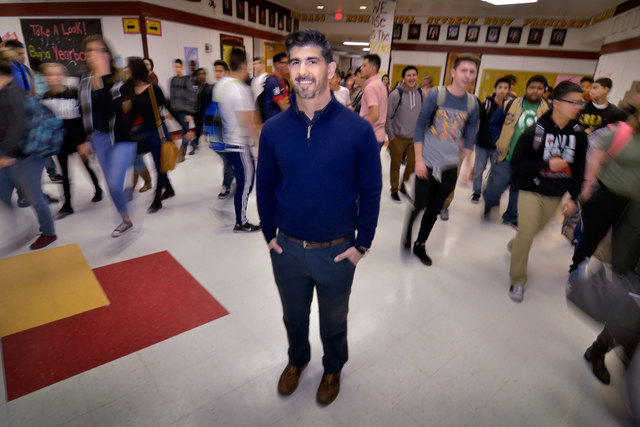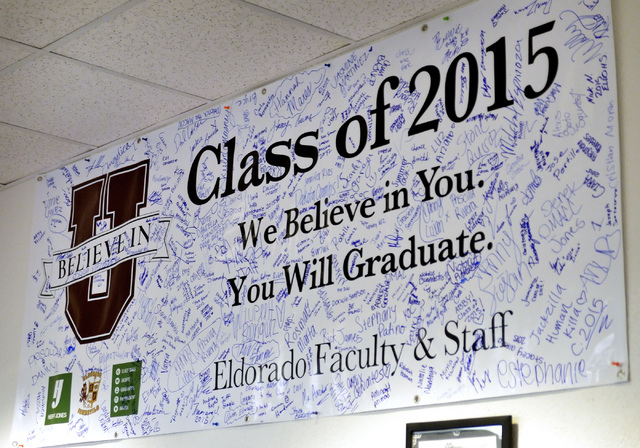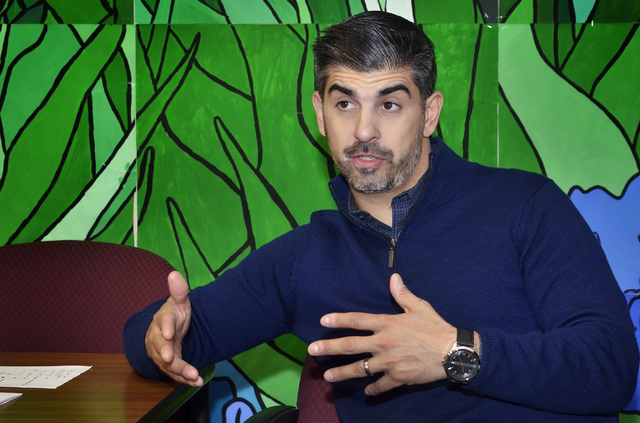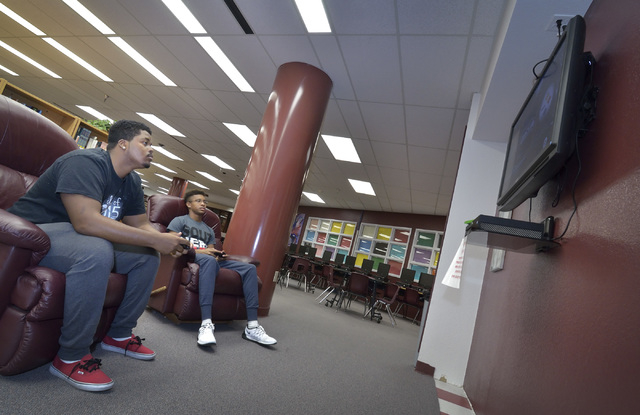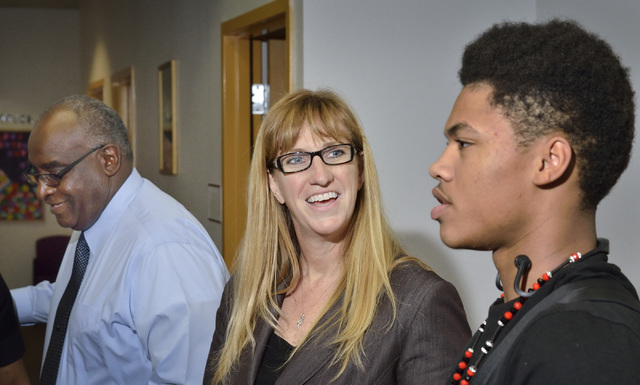Eldorado fuels graduation rate gains with what students want, need
When John Anzalone walked into Eldorado High School as the new principal in 2012, the graduation rate that met him at the door was just 45 percent.
The 38-year-old administrator told himself there was nowhere to go but up.
Laying the groundwork for change didn’t involve rocket science. It did entail a focused effort on making school a place where students want to be, he said. Those efforts have Anzalone hoping to see 75 percent of the class of 2015 earn diplomas, which would be the highest percentage the campus of 1,950 students has seen in nearly 20 years.
“If kids aren’t happy here, they’re not going to show up,” Anzalone recently told the Review-Journal. “So who are you going to teach? Three kids and 25 empty seats?”
Eldorado’s situation is by no means unique in the Clark County School District. With its average graduation rate hovering at 71 percent, the district showed no overall improvement in 2014. Last year’s rate of 70.9 percent was slightly below 2013’s 71.5 percent.
But hard-fought gains are happening at individual campuses — 10 individual schools charted increases of 10 percentage points or more from 2013 to 2014. And Eldorado, an east valley school with a history of high dropout rates and frequent staff turnover, was one of them.
Anzalone is the fourth principal in eight years at the campus near Washington Avenue and Nellis Boulevard. During his watch, the Sun Devils’ graduation rate soared from the 45 percent he inherited in 2012 to nearly 70 percent in 2014.
“Nobody ever said ‘this is what you need to do,’ ” Anzalone said. “So I had to figure out what this school needed and what direction it needed to go.”
His evolving plan entails providing students with what they want — and what they need. From giving students traditional academic leg-ups to creating social learning areas that keep them on campus after school, his main goal is keeping kids focused and on track to graduate.
The transformation began with reviving the school’s fine arts programs, which had been in decline since 2009. Eldorado’s choir program was reintroduced in 2013 after four years of silence.
A nationally recognized program in the 1980s, 1990s and early 2000s, the Sun Devils’ choir regularly won competitions, and once performed for Reagan-era officials at the Lincoln Memorial in Washington, D.C. The choir, once 300 students strong, was named a 2001 Grammy Signature School, an annual award given to a small number of schools across the nation.
But budget cuts, enrollment shifts to other campuses and the retirement of longtime teacher Janet Tyler left the program in shambles. It was cut in 2009.
“Our music hall, which had been so important to us in the past, was completely empty when I got here,” Anzalone said. “I didn’t even have the key to get in.”
It didn’t take long to breathe new life into the choir program, which is again competitive under the direction of 25-year-old teacher Matt Ostlie. On March 9, 30 Eldorado singers earned a rating of “Excellent” at the district’s Advanced Choir Festival.
Ostlie, a South Dakota native who was 23 when he started teaching at Eldorado in 2013, said trust from Anzalone’s administration and the freedom to use his own lesson plan has allowed the program to flourish. As a result, students are becoming more involved in the program instead of going home after school.
The choir, which had about 60 students his first year, now stands at nearly 120 — a number he again hopes to double by 2016.
“All through college they prepare you for horror stories with administration, but my experience here has been the total opposite,” said Ostlie, a 2013 graduate of South Dakota State University.
“Mr. Anzalone is very motivating and supportive of all of us, his staff and his students.”
Anzalone also added classes in Mariachi, a popular genre of Mexican folk music, to interest the school’s growing Hispanic population, he said.
Second-year teacher Noe Cervantes said the program is becoming increasingly diverse and perhaps more importantly, fun.
“Every semester we have more kids involved,” Cervantes said.
LIBRARY TO DIGITAL LAB
Fun is something Anzalone embraces, and when working with students, he isn’t afraid to emphasize it as part of the school’s culture change.
An example: Anzalone this winter helped students convert the school’s 42-year-old library into a digital media lab, called Cafe ’15 in honor of this year’s senior class.
The lab features a cafe serving a variety of catered food, including sandwiches, chicken wings and drinks. The space once filled with bookshelves and a card catalog now features computers, big screen TVs and the latest video games for XBox One, PlayStation 4 and Nintendo Wii.
Anzalone estimates that between 20 and 30 students use Cafe ’15 daily, mostly athletes waiting for practice to start. The old library sat nearly empty for a year before it was transformed in December, he said.
Tyler Spivey, 17, who helped design the lab, is a two-sport athlete, starring on Eldorado’s varsity football and track teams. The senior, who has earned a full scholarship to Southern Utah University, said the media lab gives athletes reason to stay on campus between the end of school at 12:45 p.m. and the beginning of athletic practices, which start about 4:00 p.m.
“Usually I’d just go home or sit in a favorite teacher’s classroom,” Spivey said. “Now we have more of a place to relax and hang out.”
Senior Ray’Shawn Gamble, 17, said Cafe ’15 helps keeps Eldorado students get off the street and out of trouble. A co-designer of the lab, Gamble said he spends a combined three hours there every day, before and after school.
“It’s generally a mixture of people, not just athletes,” Gamble said. “A lot of kids on the computers, others chatting, studying and playing games.”
In an important administrative move, Anzalone and two secretaries also started cracking down on graduation rate problem areas, specifically a list of 140 “unsuccessful transfer” students. If unaccounted for, unsuccessful transfer students count against a school’s graduation rate.
Through Facebook, Anzalone said his administration successfully found 20 of 140 transfer students were enrolled in schools elsewhere, which keeps them from counting against Eldorado’s graduation rate.
“Some of them were actually in another country, taking classes, and some of them got a GED,” he explained.
TUTORING AND TRUANCY COURT
While Eldorado continues to show progress, the third-year principal said there’s still a long way to go. The school will become a magnet school focused on video game technology and Web design in 2015-16, he said, and new Advanced Placement courses like music theory and human geography are set to become part of the Eldorado curriculum next year.
Academic help is also more available to struggling students, Anzalone said. In addition to free after-school tutoring, Eldorado students can get help at the school’s on-site United Way Family Engagement Resource Center and through local programs like UNLV’s Gear Up and Upward Bound, which also offer student assistance. Last fall, Eldorado also began offering free Saturday tutoring every other week, and on the Saturdays before proficiency exams and state testing are given.
The tutoring programs at the school reach nearly 400 Eldorado students, Anzalone estimated. And the results have been noticeable. About 47 percent of this year’s juniors passed the writing section of the Nevada High School Proficiency Exam on the first try — the best percentage Anzalone has ever seen for Eldorado.
“The tutoring is making an obvious difference, it’s huge,” he said. “It keeps our kids thinking about school and it’s pushing borderline students over that edge between not passing and passing these exams.”
Truants at Eldorado also have come under closer scrutiny, the principal said, thanks to a recently implemented, in-house truancy court, an idea Anzalone first used as principal of Global Community High School in 2011.
In the presence of an attorney acting as a judge, students with double-digit absences are called to a weekly hearing and questioned, Anzalone said. A point system is used to measure improved attendance.
The truants and their parents also work to identify the reasons why the teens are skipping school and then formulate an improvement plan.
Students in Anzalone’s truancy court are offered incentives, like gift cards, for improved attendance, he said. When the judge decides a student has reached an acceptable attendance level, that student “graduates” from truancy court.
The court, which started less than a month ago, targets students with roughly 15 to 20 absences. About a dozen kids have appeared in Eldorado’s weekly truancy court in its first month of existence, he said.
“We want to get kids we think are salvageable,” Anzalone said. “We know that they’re bright, and if they came to school they’d be better.”
Anzalone said no one gave him a specific road map on how to improve graduation rates, but he recognizes that his struggle to put diplomas in the hands of more students is a common one, especially in the Silver State.
“If Nevada is 50th in the country in graduation rates, something has got to change,” he said. “Let’s run our schools and ask for forgiveness later.”
Contact Chris Kudialis at ckudialis@reviewjournal.com or 702-383-0283. Find him on Twitter: @kudialisrj



